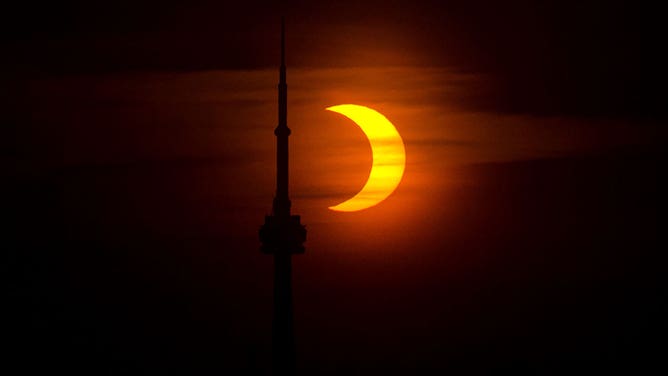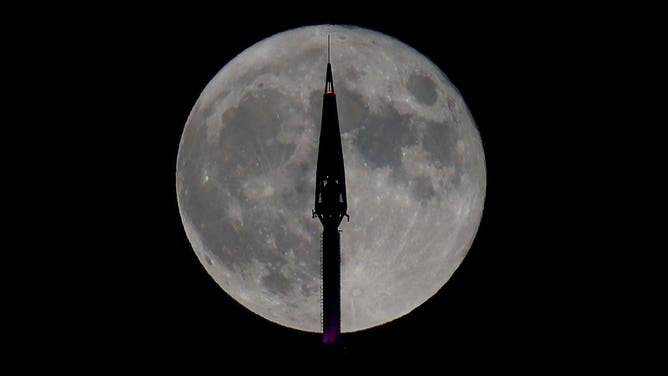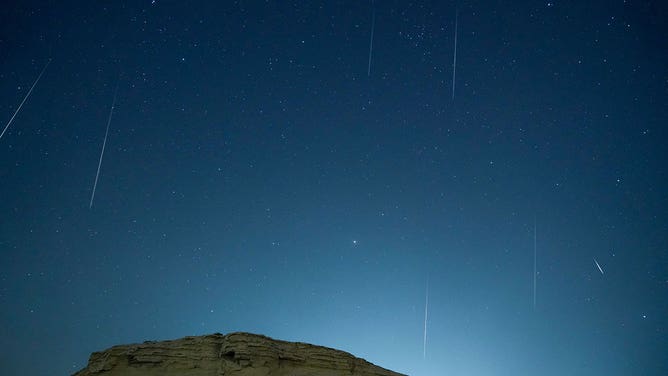Astronomical events you'll want to watch in 2022
Eclipses and meteor showers and supermoons, oh my!

The Beaver Moon partial eclipse reddens the moon in Bloomington, Indiana, in November 2021.
(Jeremy Hogan/SOPA Images/LightRocket via Getty Images)
From eclipses to meteor showers to supermoons, there is a lot to keep sky watchers busy in 2022.
Here is a look at astronomical events you can’t miss.
Total lunar eclipses
Two total lunar eclipses will be visible in the Northern Hemisphere this year.
The first starts about 8:30 p.m. Central on May 16. It peaks about 11:30 p.m. Central and ends about 1:50 a.m. Central. For the U.S., the entire eclipse will be visible across the eastern half of the country. However, the western half will still see most of it.
The second happens on Nov. 8. It starts about 2 a.m. Central, peaks about 5 a.m. Central and ends just before 8 a.m. Central. For the U.S., the entire eclipse will be visible across the western third of the country. The rest of the country will see most of the eclipse.
The moon will take on a red hue as the Earth moves between the moon and the sun. Unlike a solar eclipse, you don’t need any special glasses to view a lunar eclipse.
2 partial solar eclipses

A partial solar eclipse is seen from Toronto, Canada, on June 10, 2021.
(Zou Zheng/Xinhua via Getty Images)
There will be two partial solar eclipses in 2022, but neither of them are visible in the U.S.
The Southern Hemisphere will be treated to the first partial solar eclipse of the year on April 30 and will be visible from Peru to Antarctica.
The second happens on Oct. 25 and will be visible in Asia, Europe and parts of Africa.
A solar eclipse happens when the moon moves between the Earth and the sun. You need special glasses to view an eclipse directly. There are also alternative ways to view an eclipse by observing the shadow that is cast on the ground.
3 supermoons

The Super Strawberry Moon rises behind the antenna on One World Trade Center in New York City on June 24, 2021 as seen from Jersey City, New Jersey.
(Gary Hershorn/Getty Images)
There will be three supermoons in 2022.
The first happens on June 14 and is called the Strawberry Moon. The second is on July 13 and is called the Buck Moon. The third is on August 12 and is called the Sturgeon Moon.
A supermoon happens when the full moon coincides with the point in the moon’s orbit that it is closest to the Earth. That point is called perigee. This makes it appear larger and brighter than a typical full moon.
Meteor showers

A meteor streaks across the night sky in Bazhou, Xinjiang Province, China, in the early morning of December 14, 2021.
(Xue Bing / Costfoto/Future Publishing via Getty Images)
Quadrantids: Dec. 28 to Jan. 12, peaks Jan. 3-4, look northeast between midnight and sunrise.
Lyrids: April 14-30, peaks April 22-23, look east-northeast toward the constellation Lyra between 10 p.m. and sunrise.
Eta Aquarids: April 19 to May 28, peaks May 5-6, look east toward the constellation Aquarius between 3 a.m. and sunrise.
Perseids: July 17 to Aug. 24, peaks Aug. 12-13, look north-northeast toward the constellation Perseus between 9 p.m. and sunrise.
Draconids: Oct. 6-10, peaks Oct. 8-9, look northwest toward the constellation Draco between 7 p.m. and 3 a.m.
Orionids: Oct. 2 to Nov. 7, peaks Oct. 21-22, look east-northeast toward the constellation Orion between midnight and sunrise.
Leonids: Nov. 6-30, peaks Nov. 17-18, look east-northeast toward the constellation Leo between midnight and sunrise.
Geminids: Dec. 4-20, peaks Dec. 13-14, look west-northwest toward the constellation Gemini between 7 p.m. and sunrise.
Ursids: Dec. 17-26, peaks 21-22, look north toward the constellation Ursa Minor between 5 p.m. and sunrise.